#Mercury Spacecraft No. 20
Explore tagged Tumblr posts
Text

"The Space Shuttle Enterprise (back) and Mercury Capsule 15B 'Freedom 7-II' (front) is among many spacecraft that is on display at the National Air and Space Musuem, Steven F. Udvar-Hazy Center where opening ceremonies took place, in Chantilly, Virginia. The museum, featuring over 80 aircraft, some 60 large space artifacts and dozens of aircraft engines and other artifacts displayed in thematic groupings, will be open to the public, December 15, 2003."
Date: December 11, 2003
2803357
#Mercury-Atlas 10#MA-10#Freedom 7-II#Mercury Spacecraft No. 20#Mercury Program#Project Mercury#cancelled#Space Shuttle#Space Shuttle Enterprise#Enterprise#OV-101#Orbiter#NASA#Space Shuttle Program#Steven F. Udvar-Hazy Center#Udvar-Hazy Center#National Air and Space Museum#NASM#Smithsonian Institute#Smithsonian#Museum#December#2003#Cancelled Mission#my post
33 notes
·
View notes
Photo
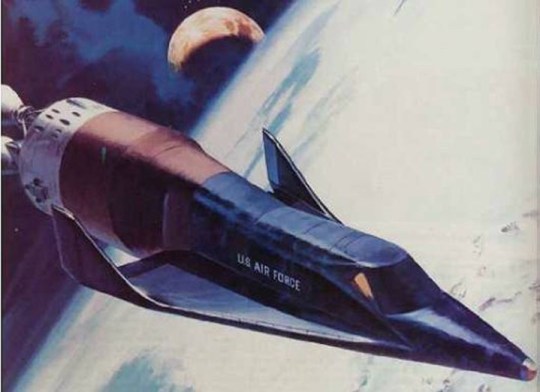
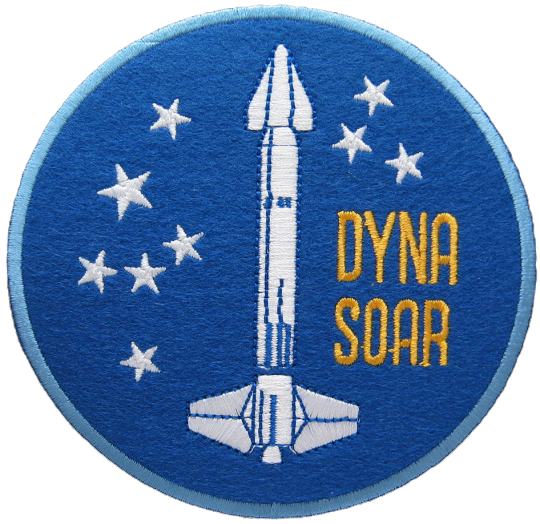
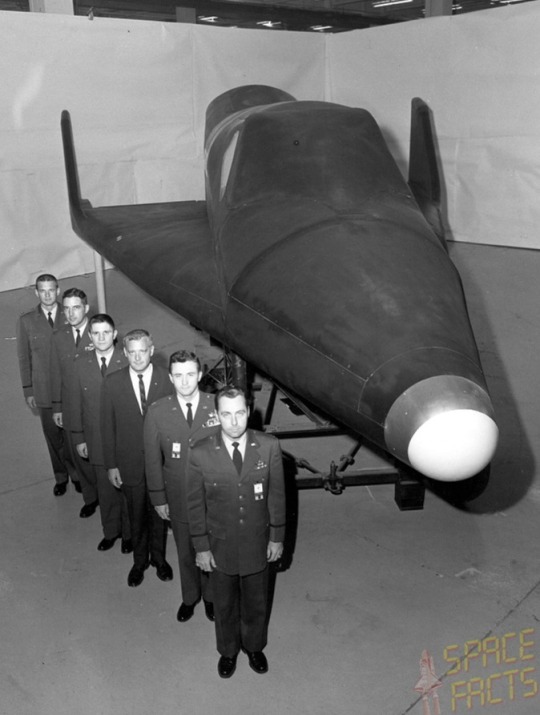

December 10, 1962: The US Air Force cancels its X-20 Dyna Soar program
The X-20 Dyna Soar was a reusable manned spaceplane developed for reconnaissance, space rescue, and satellite interception and maintenance. Its reusability and ability to be launched on different boosters made it more advanced than other spacecraft of the time, such as the American Mercury and Soviet Vostok capsules. It is best remembered as the predecessor to spaceplanes of the the current and most previous generation, such as the Space Shuttle Orbiter and Sierra Nevada Dream Chaser.
Learn more about the X-20 Dyna Soar here!
35 notes
·
View notes
Text



Gigantic asteroid impact shifted the axis of Solar System's biggest moon
Around 4 billion years ago, an asteroid hit the Jupiter moon Ganymede. Now, a Kobe University researcher realized that the Solar System's biggest moon's axis has shifted as a result of the impact, which confirmed that the asteroid was around 20 times larger than the one that ended the age of the dinosaurs on Earth, and caused one of the biggest impacts with clear traces in the Solar System.
Ganymede is the largest moon in the Solar System, bigger even than the planet Mercury, and is also interesting for the liquid water oceans beneath its icy surface. Like the Earth’s moon, it is tidally locked, meaning that it always shows the same side to the planet it is orbiting and thus also has a far side. On large parts of its surface, the moon is covered by furrows that form concentric circles around one specific spot, which led researchers in the 1980s to conclude that they are the results of a major impact event. “The Jupiter moons Io, Europa, Ganymede and Callisto all have interesting individual characteristics, but the one that caught my attention was these furrows on Ganymede,” says the Kobe University planetologist HIRATA Naoyuki. He continues, “We know that this feature was created by an asteroid impact about 4 billion years ago, but we were unsure how big this impact was and what effect it had on the moon.”
Data from the remote object is scarce making research very difficult, and so Hirata was the first to realize that the purported location of the impact is almost precisely on the meridian farthest away from Jupiter. Drawing from similarities with an impact event on Pluto that caused the dwarf planet’s rotational axis to shift and that we learned about through the New Horizons space probe, this implied that Ganymede, too, had undergone such a reorientation. Hirata is a specialist in simulating impact events on moons and asteroids, so this realization allowed him to calculate what kind of impact could have caused this reorientation to happen.
In the journal Scientific Reports, the Kobe University researcher now published that the asteroid probably had a diameter of around 300 kilometers, about 20 times as large as the one that hit the Earth 65 million years ago and ended the age of the dinosaurs, and created a transient crater between 1,400 and 1,600 kilometers in diameter. (Transient craters, widely used in lab and computational simulations, are the cavities produced directly after the crater excavation and before material settles in and around the crater.) According to his simulations, only an impact of this size would make it likely that the change in the distribution of mass could cause the moon’s rotational axis to shift into its current position. This result holds true irrespective of where on the surface the impact occurred.
“I want to understand the origin and evolution of Ganymede and other Jupiter moons. The giant impact must have had a significant impact on the early evolution of Ganymede, but the thermal and structural effects of the impact on the interior of Ganymede have not yet been investigated at all. I believe that further research applying the internal evolution of ice moons could be carried out next,” explains Hirata.
Interesting for its subsurface oceans, Ganymede is the final destination of ESA’s JUICE space probe. If everything goes well, the spacecraft will enter orbit around the moon in 2034 and will make observations for six months, sending back a wealth of data that will help answer Hirata’s questions.
TOP IMAGE: Kobe University HIRATA Naoyuki was the first to realize that the location of an asteroid impact on Jupiter’s moon Ganymede is almost precisely on the meridian farthest away from Jupiter. This implied that Ganymede had undergone a reorientation of its rotational axis and allowed Hirata to calculate what kind of impact could have caused this to happen. Credit HIRATA Naoyuki
CENTRE IMAGES: On large parts of its surface, the Jupiter moon Ganymede is covered by furrows (right) that form concentric circles around one specific spot (left, red cross), which led researchers in the 1980s to conclude that they are the results of a major impact event. Credit HIRATA Naoyuki
LOWER IMAGES: Distribution of furrows and the location of the center of the furrow system shown in the hemisphere that always faces away from Jupiter (top) and the cylindrical projection map of Ganymede (bottom). The gray regions represent geologically young terrain without furrows. Furrows (green lines) exist only on geologically old terrains (black regions). Credit HIRATA Naoyuki
8 notes
·
View notes
Text
Science fact of the day- Dyson Sphere!
okay we're done with rocket engines. i told you i had a lot. anyways yesterday i mentioned dyson spheres, and i so i figured i'd elaborate on that. A dyson sphere is the name for a hypothetical structure which would harvest a larger percentage of the sun's energy. The original concepts of a Dyson sphere pictured building an entire, solid sphere around the sun. However, this has a few major difficulties. for one, getting enough material might be physically impossible- and if it was possible, it'd require like, mining the entire planet of mercury and maybe venus too. the second problem is that structurally, it'd be insanely difficult to hold up. even if you spun it around the center (thus essentially having it orbit and therefore hold its own weight), the top and bottom would still want to collapse in and apply great structural pressure on the rest of the structure, and if any part of it started collapsing, the entire thing might collapse. So while the benefits of harvesting an entire star's worth of energy are great, it'd be a near impossible task. However, if we could still capture a good fraction of that energy, it'd be insanely beneficial.
The sun produces roughly 3.8 x 10^26 joules of energy every single second. that's 380000000000000000000000000 joules, in a single second. Earth, right now, is the primary place where humans need energy- in 2013, we used about 3.8 x 10^20 joules. which is still a hell of a lotta joules, but that's a million times less than what the sun made, over a timespan that's 30 million times longer. so. with the suns power output, for one second, we could power 2013 earth for 30 trillion years. and while power consumption grows, if we could capture that much solar energy, we'd be set for power for thousands of years.
While an original dyson sphere probably won't work, other methods might prove more feasible. A dyson ring is similar to a dyson sphere, but it's only a thin slice of ring. While this could only access a small amount of the sun's power compared to a dyson ring, it'd still be enourmously powerful. such a structure would probably be placed in an orbit near the sun (probably within the orbit of mercury), where it could grab all that sweet sweet solar energy.
Another idea is known as a Dyson swarm. this would be a massive number of spacecraft which would orbit their host star as close as they could without burnign up, where they would harvest solar energy and beam it back to earth. To be, a dyson swarm seems like it'd be the easiest to build while still providing a huge energy output. even if .1% of the solar energy could be captured, that's billions of times what we use in a single year right now, and while such a concept probably won't become a thing too soon, it seems like it could be feasible in the next century or two, at which point our energy demands likely will've only grown by perhaps an order of magnitude or two.
#science fact of the day#sfotd 29#honestly fuck if i know these numbers sigh ill go check#sfotd- dyson sphere
4 notes
·
View notes
Text
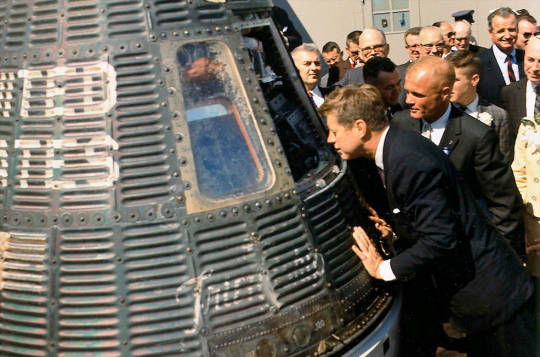
60 Years Ago: John Glenn, the First American to Orbit the Earth aboard Friendship 7
On Feb. 20, 1962, astronaut John H. Glenn became the first American to orbit the Earth during the three-orbit Mercury-Atlas 6 mission, aboard the spacecraft he named Friendship 7.
The Soviets had leaped ahead the year before by placing the first man, Yuri A. Gagarin, in space on April 12, 1961, on a one-orbit flight around the Earth aboard his Vostok 1 spaceship. The Soviets followed that up on August 6 by keeping a cosmonaut in space for a full day with Gherman Titov in Vostok 2.
10 notes
·
View notes
Text

Venus: Earth's Sister Planet - August 15th, 1995.
"This picture in visible light was taken by the Galileo spacecraft. Venus is very similar to Earth in size and mass - and so is sometimes referred to as Earth's sister planet - but Venus has a quite different climate. Venus' thick clouds and closeness to the Sun (only Mercury is closer) make it the hottest planet - much hotter than the Earth. Humans could not survive there, and no life of any sort has ever been found. When Venus is visible it is usually the brightest object in the sky after the Sun and the moon. More than 20 spacecraft have visited Venus, including Venera 9, which landed on the surface, and Magellan, which used radar to peer through the clouds and make a map of the surface. There are still many things about Venus' unusual atmosphere that astronomers don't understand."
2 notes
·
View notes
Text
Why is Mercury the smallest planet and Jupiter the largest planet
Why is Mercury the smallest planet and Jupiter the largest planet
Mercury is the smallest planet in our solar system because it has the smallest mass and circumference, while Jupiter is the largest because it's much larger than Earth and has a much higher mass:
Size
Mercury is about 4,879 kilometers across, which is about 2.5 times smaller in diameter than Earth. Jupiter is more than ten times larger than Earth.
Mass
Mercury is nearly 20 times less massive than Earth. Jupiter has 5,750 times more mass than Mercury.
Composition
Mercury is a rocky planet, while Jupiter is a gas giant. Rocky planets are denser than gas giants because they're made of solid, dense materials like rocks and metals. Gas giants are made of hydrogen and helium gases, which are less dense but have enormous mass.
Planet Sizes and Locations in Our Solar System
NASA Science (.gov)
https://science.nasa.gov › solar-system › planet-sizes-an...
29 Mar 2024
Mercury
TERRESTRIAL
The smallest planet in our solar system and nearest to the Sun, Mercury is only slightly larger than Earth's Moon.
Mercury's surface temperatures are both extremely hot and cold. Because the planet is so close to the Sun, day temperatures can reach highs of 800°F (430°C). Without an atmosphere to retain that heat at night, temperatures can dip as low as -290°F (-180°C). From the surface of Mercury, the Sun would appear more than three times as large as it does when viewed from Earth, and the sunlight would be as much as seven times brighter. Despite its proximity to the Sun, Mercury is not the hottest planet in our solar system – that title belongs to nearby Venus, thanks to its dense atmosphere. But Mercury is the fastest planet, zipping around the Sun every 88 Earth days. Mercury's surface resembles that of Earth's moon, scarred by many impact craters resulting from collisions with meteoroids and comets. The first spacecraft to visit Mercury was Mariner 10, which imaged about 45 percent of the surface. NASA's MErcury Surface, Space ENvironment, GEochemistry, and Ranging (MESSENGER) mission flew by Mercury three times in 2008-2009 and orbited the planet from 2011 to 2015, mapping the entire surface.
Jupiter
Size and Distance
With a radius of 43,440.7 miles (69,911 kilometers), Jupiter is 11 times wider than Earth. If Earth were the size of a grape, Jupiter would be about as big as a basketball.
From an average distance of 484 million miles (778 million kilometers), Jupiter is 5.2 astronomical units away from the Sun. One astronomical unit (abbreviated as AU), is the distance from the Sun to Earth. From this distance, it takes sunlight 43 minutes to travel from the Sun to Jupiter.
Magnetosphere
The Jovian magnetosphere is the region of space influenced by Jupiter's powerful magnetic field. It balloons 600,000 to 2 million miles (1 to 3 million kilometers) toward the Sun (seven to 21 times the diameter of Jupiter itself) and tapers into a tadpole-shaped tail extending more than 600 million miles (1 billion kilometers) behind Jupiter, as far as Saturn's orbit. Jupiter's enormous magnetic field is 16 to 54 times as powerful as that of the Earth. It rotates with the planet and sweeps up particles that have an electric charge. Near the planet, the magnetic field traps swarms of charged particles and accelerates them to very high energies, creating intense radiation that bombards the innermost moons and can damage spacecraft.
Jupiter's magnetic field also causes some of the solar system's most spectacular aurorae at the planet's poles.
Mercury is the smallest planet, probably the nearest planet to the Sun.
And Jupiter, the protector of the planets and the first planet to start the asteroid belt, probably became the biggest planet to keep everything under control.
By the way, this asteroid belt between Mars, the last of the terrestrial planets, and Jupiter, among the gaseous giant Jovian planets, is the most miraculous glory of the solar system.
Translate Hindi
क्यों बुध ग्रह सबसे छोटा बृहस्पति ग्रह सबसे बड़ा बना है
बुध हमारे सौरमंडल का सबसे छोटा ग्रह है क्योंकि इसका द्रव्यमान और परिधि सबसे कम है, जबकि बृहस्पति सबसे बड़ा है क्योंकि यह पृथ्वी से बहुत बड़ा है और इसका द्रव्यमान भी बहुत अधिक है:
आकार
बुध लगभग 4,879 किलोमीटर चौड़ा है, जो पृथ्वी से व्यास में लगभग 2.5 गुना छोटा है। बृहस्पति पृथ्वी से दस गुना से भी अधिक बड़ा है।
द्रव्यमान
बुध पृथ्वी से लगभग 20 गुना कम भारी है। बृहस्पति का द्रव्यमान बुध से 5,750 गुना अधिक है।
संरचना
बुध एक चट्टानी ग्रह है, जबकि बृहस्पति एक गैस दानव है। चट्टानी ग्रह गैस दानवों की तुलना में अधिक सघन होते हैं क्योंकि वे चट्टानों और धातुओं जैसे ठोस, सघन पदार्थों से बने होते हैं। गैस दानव हाइड्रोजन और हीलियम गैसों से बने होते हैं, जो कम घने होते हैं लेकिन उनका द्रव्यमान बहुत अधिक होता है।
हमारे सौर मंडल ��ें ग्रहों के आकार और स्थान
NASA विज्ञान (.gov)
https://science.nasa.gov › solar-system › planet-sizes-an...
29 मार्च 2024
बुध
स्थलीय
हमारे सौर मंडल का सबसे छोटा ग्रह और सूर्य के सबसे निकट, बुध पृथ्वी के चंद्रमा से थोड़ा ही बड़ा है।
बुध की सतह का तापमान अत्यधिक गर्म और ठंडा दोनों है। चूँकि ग्रह सूर्य के बहुत करीब है, इसलिए दिन का तापमान 800°F (430°C) तक पहुँच सकता है। रात में उस गर्मी को बनाए रखने के लिए वायुमंडल के बिना, तापमान -290°F (-180°C) तक गिर सकता है। बुध की सतह से, सूर्य पृथ्वी से देखने पर तीन गुना से अधिक बड़ा दिखाई देगा, और सूर्य का प्रकाश सात गुना अधिक चमकीला होगा। सूर्य से अपनी निकटता के बावजूद, बुध हमारे सौर मंडल का सबसे गर्म ग्रह नहीं है - यह खिताब पास के शुक्र ग्रह का है, जो इसके घने वायुमंडल के कारण है। लेकिन बुध सबसे तेज़ ग्रह है, जो हर 88 पृथ्वी दिनों में सूर्य के चारों ओर चक्कर लगाता है। बुध की सतह पृथ्वी के चंद्रमा से मिलती जुलती है, जो उल्कापिंडों और धूमकेतुओं से टकराव के परिणामस्वरूप कई प्रभाव क्रेटरों से क्षतिग्रस्त है। बुध पर जाने वाला पहला अंतरिक्ष यान मेरिनर 10 था, जिसने सतह के लगभग 45 प्रतिशत हिस्से की तस्वीर ली। नासा के मर्करी सरफेस, स्पेस एनवायरनमेंट, जियोकेमिस्ट्री, और रेंजिंग (मेसेंजर) मिशन ने 2008-2009 में तीन बार बुध के पास से उड़ान भरी और 2011 से 2015 तक ग्रह की परिक्रमा की, जिससे पूरी सतह का मानचित्रण हुआ।
बृहस्पति
आकार और दूरी
43,440.7 मील (69,911 किलोमीटर) की त्रिज्या के साथ, बृहस्पति पृथ्वी से 11 गुना चौड़ा है। अगर पृथ्वी एक अंगूर के आकार की होती, तो बृहस्पति लगभग एक बास्केटबॉल जितना बड़ा होता।
484 मिलियन मील (778 मिलियन किलोमीटर) की औसत दूरी से, ब��हस्पति सूर्य से 5.2 खगोलीय इकाइयों की दूरी पर है। एक खगोलीय इकाई (जिसे संक्षेप में AU कहा जाता है), सूर्य से पृथ्वी की दूरी है। इस दूरी से, सूर्य से बृहस्पति तक पहुँचने में सूर्य की रोशनी को 43 मिनट लगते हैं।
चुंबकमंडल
जोवियन मैग्नेटोस्फीयर अंतरिक्ष का वह क्षेत्र है जो बृहस्पति के शक्तिशाली चुंबकीय क्षेत्र से प्रभावित होता है। यह सूर्य की ओर 600,000 से 2 मिलियन मील (1 से 3 मिलियन किलोमीटर) तक (बृहस्पति के व्यास से सात से 21 गुना) तक फैलता है और बृहस्पति के पीछे 600 मिलियन मील (1 बिलियन किलोमीटर) से अधिक दूर शनि की कक्षा तक एक टैडपोल के आकार की पूंछ में पत��ा हो जाता है। बृहस्पति का विशाल चुंबकीय क्षेत्र पृथ्वी के चुंबकीय क्षेत्र से 16 से 54 गुना अधिक शक्तिशाली है। यह ग्रह के साथ घूमता है और उन कणों को अपने साथ ले जाता है जिनमें विद्युत आवेश होता है। ग्रह के पास, चुंबकीय क्षेत्र आवेशित कणों के झुंड को फँसाता है और उन्हें बहुत अधिक ऊर्जा तक गति देता है, जिससे तीव्र विकिरण उत्पन्न होता है जो सबसे भीतरी चंद्रमाओं पर बमबारी करता है और अंतरिक्ष यान को नुकसान पहुँचा सकता है।
बृहस्पति का चुंबकीय क्षेत्र ग्रह के ध्रुवों पर सौरमंडल के कुछ सबसे शानदार ध्रुवीय प्रकाश का भी कारण बनता है।
बुध ग्रह सबसे छोटा शयद सूरज की निकट ग्रह इसलिए
और ग्रहों के रक्षक और क्षुद्रग्रह बेल्ट की सबसे पहले शुरु की ग्रह बृहस्पति ग्रह शायद सबकुछ नियंत्रण में रखने के लिए ही सबसे बड़ा ग्रह बना होगा
वैसे टेरेस्ट्रियल ग्रहों की सबसे बाद की मंगल ग्रह और गैसीय दिग्गज जोवियन ग्रहों में बृहस्पति ग्रह के बीच यह जो क्षुद्रग्रह बेल्ट है यह बेल्ट ही है सौरमंडल का सबसे ज्यादा चमत्कारी महिमा
0 notes
Text
NASA’s SERT II: 'A Genuine Space Success Story’
New Post has been published on https://sunalei.org/news/nasas-sert-ii-a-genuine-space-success-story/
NASA’s SERT II: 'A Genuine Space Success Story’
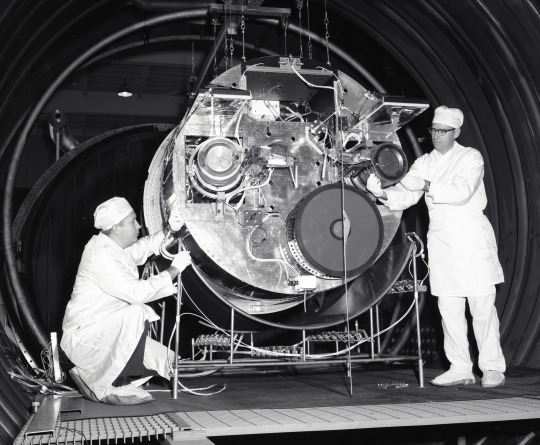
“A genuine space success story,” is how Experiments Manager William Kerslake described NASA’s second Space Electric Rocket Test (SERT II), the first long-duration operation of ion thrusters in space. SERT II provided researchers with data for years beyond its expected lifetime and was a rare example of an entire mission – including the launch, propulsion system, spacecraft, and control center – being handled by one organization: NASA’s Lewis Research Center in Cleveland (today, NASA Glenn).
The concept of electric propulsion thrusters dates back to the early 20th century, but because they must operate in a vacuum, there was no practical application for these systems until the space program decades later. In the late 1950s, researchers at NASA Lewis began investigating types of electric propulsion and analyzing missions that could use these systems. They produce low amounts of thrust by creating and accelerating small particles at high velocities, and over time, can accelerate spacecraft at very high rates of speed. Their ability to operate continuously for years at a time with little propellant makes them ideal for long-duration missions or keeping satellites in orbit.
This work was expanded in the early 1960s with the creation of Lewis’ Electromagnetic Propulsion Division and the construction of large vacuum facilities, including the Electric Propulsion and Power Laboratory (EPPL). Lewis engineer Harold Kaufman’s electron bombardment ion engine, which used liquid mercury as its propellant, was the most promising option. While Kaufman’s thruster was undergoing extensive testing in the EPPL tanks, Lewis engineers began developing a spacecraft to test the thruster. During the 50-minute suborbital SERT I flight on July 20, 1964, the Kaufman thruster became the first ion engine to operate in space.
Lewis continued improving the thruster system, and in August 1966 received approval for SERT II. Researchers wanted to verify the thrusters could operate for longer durations in space, determine their effect on other spacecraft systems, and measure the degradation of solar arrays over time.
The center began simultaneous development of the SERT II ion thruster system and the spacecraft that would place it into orbit: a Thorad-Agena rocket. SERT II had two 15-centimeter diameter electron bombardment thrusters affixed to the back end and a 5-by-40 foot solar array, the largest ever flown by NASA at that time, at the other end.
After a series of tests in the EPPL, SERT II blasted off on February 3, 1970. Project Manager Raymond Rulis called the launch “one of the smoothest operations I’ve seen.” SERT II was placed into a circular polar orbit that provided its solar arrays with the continuous sunlight required to power its thrusters and electronic systems.
On February 14, 1970, Lewis engineers activated the first thruster, beginning its six-month operational test. Three weeks later, operators shut the thruster down just before the vehicle passed through the path of a solar eclipse. It was restarted without issue afterwards and continued operation as the spacecraft encountered the eclipse a second time later that day.
The thruster operated successfully for five months until an electrical short in the grid caused it to fail on July 22, 1970. Two days later, the second thruster was activated. It operated smoothly for three-and-a-half months until a similar short occurred in mid-October. Though the SERT II thrusters failed to meet their six-month objectives, they did operate for extended periods, confirming data obtained in Lewis’ vacuum tanks.
The mission continued when Lewis engineers reactivated SERT II in 1973 to demonstrate cathode restarting, and the following year, they resolved an electrical short in one of the thrusters. During periods of intermittent sunlight, operators demonstrated restarting the thruster with less than an hour of power available. SERT II’s return to an orbit in continuous sunlight in 1979 provided Lewis researchers the opportunity to conduct over 500 restarts. They operated the thruster for 18,000 hours before the propellant ran out in the spring of 1981.
Over eleven years, SERT II provided data on hundreds of thruster restarts, restarts after shutdowns as long as 18 months, ion beam neutralization of one thruster by the other, and discovery of a new plasma thrust mode. SERT II also verified that thruster operation had no harmful impact on spacecraft and solar arrays.
Still, SERT II continued to be an asset to NASA researchers. In the late 1980s, Lewis engineers realized that an auxiliary experiment on SERT II that analyzed the effect of micrometeoroids on solar mirrors could be beneficial to research on solar dynamic systems to power space stations. During six months in sunlight in 1990, the Lewis team determined that after 20 years in orbit, there was no degradation of the solar mirror’s optical properties.
Many technological components of the SERT II thruster system were incorporated into subsequent generations of ion thrusters. By the time the mission was terminated, Lewis was already ground testing thrusters twice the size of those on SERT II. The center has continued to lead NASA’s electric propulsion efforts, developing an array of technologies, including the NEXT-C thrusters that powered the Deep Space 1 and Dawn spacecraft. In support of the agency’s Artemis missions, NASA Glenn recently tested the thrusters that will power Gateway, NASA’s future lunar space station.
Additional Information:
Development and Flight History of SERT II Spacecraft
NASA Glenn Solar Electric Propulsion
0 notes
Text
Today in History: Today is Tuesday, Feb. 20, the 51st day of 2024.
On this date: In 1943, The Saturday Evening Post publishes the first of Norman Rockwell's Four Freedoms in support of United States President Franklin Roosevelt's 1941 State of the Union address theme of Four Freedoms.
By The Associated Press Today’s Highlight in History: On Feb. 20, 1962, astronaut John Glenn became the first American to orbit the Earth as he flew aboard Project Mercury’s Friendship 7 spacecraft, which circled the globe three times in a flight lasting 4 hours, 55 minutes and 23 seconds before splashing down safely in the Atlantic Ocean 800 miles southeast of Bermuda. On this date: In 1792,…

View On WordPress
0 notes
Text
The first person to orbit the earth
On February 20, 1962, a historic moment took place in the realm of space exploration as astronaut John Glenn became the first American to orbit the Earth. This monumental achievement was made possible through Project Mercury, a program initiated by NASA to send humans into space. Glenn’s mission, aboard the Friendship 7 spacecraft, marked a significant milestone in the United States’ efforts to…

View On WordPress
0 notes
Link
Astronaut Alan B. Shepard Jr., attired in his Mercury pressure suit, poses for a photo on May 5, 1961, prior to his launch in a Mercury-Redstone 3 spacecraft from Cape Canaveral on a suborbital mission – the first U.S. manned spaceflight.NASA Born barely 20 years after the Wright Brothers’ first flight, Alan Shepard grew up to fly combat missions in World War II, test multiple new aircraft, become the first American in space, and ultimately hit the first golf shot on the Moon. Born on Nov. 18, 1923, Shepard lifted off in the Freedom 7 spacecraft from Cape Canaveral, Florida, on May 5, 1961, beginning 62 years of Americans’ journeys into space. During the 15-minute suborbital flight, Shepard reached an altitude of 115 miles and traveled 302 miles. Grounded soon after by an inner-ear disorder, Shepard served as head of the astronaut office at NASA’s Johnson Space Center. Corrective surgery returned him to flight status, and in 1971, he commanded Apollo 14, the third lunar landing mission. Image Credit: NASA
0 notes
Text
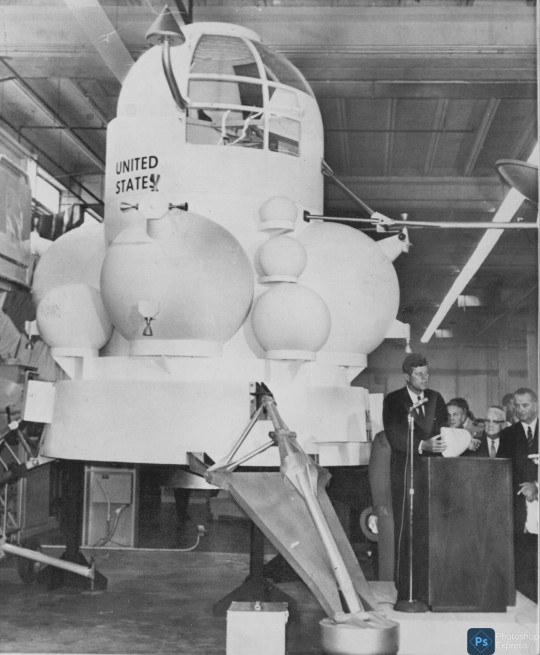
President John F. Kennedy speaks next to a prototype model of the Lunar Excursion Module, to be built by Grumman Aircraft Corporation of Long Island.
"PRESIDENT SEES 'THE BUG'
President John F. Kennedy stands before a model of the craft, known as 'The Bug' which the U.S. hores to make a lunar landing. Vice President Johnsen is at extreme right. Kennedy saw the model during his visit NASA installation in Houston today."
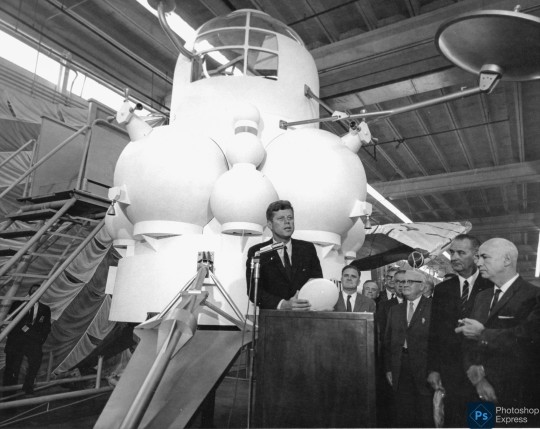
"President John F. Kennedy (at lectern) delivers remarks, following a tour of spacecraft displays inside a hangar at the Rich Building of the Manned Spacecraft Center, Houston, Texas. President Kennedy holds a scale model of the Apollo command module, presented to him by Director of the Manned Spacecraft Center, Dr. Robert Gilruth; a mock-up of the lunar lander (also known as 'the Bug') sits in background. Standing in back (L-R): Administrator of the National Aeronautics and Space Administration (NASA), Dr. James E. Webb; Governor of Texas, Price Daniel; Associate Administrator of NASA, Dr. Robert C. Seamans, Jr.; Director of Operations for Project Mercury, Dr. Walter C. Williams; Senator Alexander Wiley (Wisconsin); Vice President Lyndon B. Johnson; Dr. Gilruth. The President visited the Center as part of a two-day inspection tour of NASA field installations."

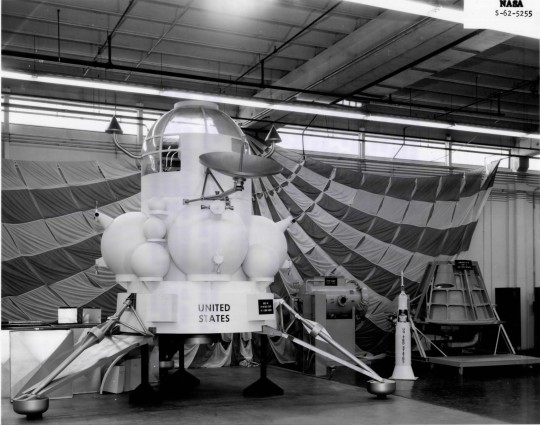
Other views of the Mockup.
Date: September 12, 1962
Long Island Daily Press Identifier: aql:33184 ldp-003526 ldp-003526
FK lib assession no. ST-387-20-62
NM Museum of Space History: link, link
#Lunar Module#NASA#Apollo Program#Mock-Up#Mock Up#Mockup#Grumman Aerospace Corporation#Grumman#Lyndon B. Johnson Space Center#Johnson Space Center#Manned Spacecraft Center#Houston#Texas#President#September#1962#my post
30 notes
·
View notes
Text
NASA’s MESSENGER spacecraft discovered strange hollows on the surface of Mercury. Images taken from orbit revealed thousands of mysterious depressions, pitted and uneven, in areas all across the planet, up to a half-mile (800 meters) across and 120 feet (37 meters) deep. This mosaic view of the Raditladi impact basin includes individual frames capturing areas about 12 miles (20 km) wide, which merged high-resolution monochrome images from MESSENGER's Narrow Angle Camera with a lower-resolution enhanced-color image from its Wide Angle Camera. For decades, scientists have been puzzling over strange hollows on Mercury’s surface, thousands of peculiar depressions at a variety of longitudes and latitudes, ranging in size from 60 feet to more than a half-mile across (18-800 meters), and up to 120 feet deep (37 meters). No one knows how they got there.
0 notes
Text
"After several unsuccessful attempts in 1992 and 1993, Oceaneering International, Inc. lifted the Liberty Bell 7 off the floor of the Atlantic Ocean and onto the deck of a recovery ship on July 20, 1999, the 30th anniversary of the Apollo 11 lunar landing.[7] The team was led by Curt Newport and financed by the Discovery Channel. The spacecraft was found after a 14-year effort by Newport at a depth of nearly 16,000 ft (4,900 m),[8] 300 nmi (350 mi; 560 km) east-southeast of Cape Canaveral.[9] Among the items found within were part of the flight gear and several Mercury dimes which had been taken to space to be souvenirs of the flight.[7]"
God so @literallymechanical told me about this the other day and I'm still laughing about it. So, Gus Grissom was a one of the original seven Project Mercury astronauts, and was actually the second American to go to space, and the second American to go to space twice. He was also a short king but we'll get to that in a bit. Here he is with the Mercury-Redstone 4 capsule, nicknamed the Liberty Bell 7!

Mercury-Redstone 4 was the second US manned spaceflight, and there were some complications after its splashdown in the Atlantic ocean when the emergency explosive bolts unexpectedly fired, opening the hatch and flooding the thing. Our boy Gus had to tread water in his spacesuit while he waited for rescue, nearly drowning the entire time. The Liberty Bell 7 couldn't be retrieved, and is currently at the bottom of the ocean.
When Gus was selected as the pilot for the first manned Gemini flight, he became heavily involved in the design of the spacecraft cockpit. He also happened to be the shortest of the original astronauts at 5'7" tall. Literally, after he was done with it, 14 out of the 16 existing astronauts could not fit inside. They had to completely change the cockpit design for future missions.
NASA didn't learn its lesson about Gus and decisions, so they let Gus give his Gemini capsule a nickname, and it went about as well as you'd expect. This is the excerpt from his Wikipedia article (image description in alt text):

Fucking hilarious. There's a specific brand of humor you see in the early US space program that I just adore. It’s a phenomenal mix of like, 60's dry military humor (all these guys were airforce pilots), and the sheer incredulity of doing something as insane as going to space. Sometimes, you just gotta laugh and name your dinky little space car after the Titanic, because the first one fucking SANK IN THE OCEAN.
218 notes
·
View notes
Text
Venus cloud 9 ExoPlanet 2016 NASA/JPL Space Art Great Gift idea for Kids Room Space Travel Poster Office, man cave, Wall Art Home Decor by VintageImageryX
14.00 USD
Venus cloud 9 ExoPlanet 2016 NASA/JPL Space Art Great Gift idea for Kids Room Space Travel Poster Office, man cave, Wall Art Home Decor The rare science opportunity of planetary transits has long inspired bold voyages to exotic vantage points – journeys such as James Cook's trek to the South Pacific to watch Venus and Mercury cross the face of the Sun in 1769. Spacecraft now allow us the luxury to study these cosmic crossings at times of our choosing from unique locales across our solar system This imaginative space travel poster design was recently made available to the public by NASA/JPL. Image Courtesy NASA/JPL want other Space posters look here: https://ift.tt/9OSMmRJ ◆ S I Z E *You can choose Your preferred size in listing size menu 8” x 12” / 20 x 30 cm 13” x 19” / 33 x 48 cm 16” x 24” / 40 x 61 cm 18” x 27” / 45 x 69 cm 20” x 30” / 51 x 76 cm 24” x 36” / 61 x 91 cm 28” x 42” / 71 x 107 cm 32” x 48” / 81 x 122 cm 36” x 54” / 91 x 137 cm 42” x 63” / 107 x 160 cm 48” x 72” / 122 x 183 cm To ensure your satisfaction, please measure your wall properly and make sure you pick the right size. ◆ NEED A CUSTOM SIZE ?!?! Send us a message and we can create you one! ◆ P A P E R Archival quality Ultrasmooth fine art matte paper 250gsm. ◆ I N K Giclee print with Epson Ultrachrome inks that will last up to 108 years indoors. ◆ B O R D E R All our prints are without border. But if You need one for framing just drop us a message. ◆FRAMING: NONE of our prints come framed, stretched or mounted. Frames can be purchased through a couple of on line wholesalers: PictureFrames.com framespec.com When ordering a frame make sure you order it UN-assembled otherwise you could get dinged with an over sized shipping charge depending on the size frame. Assembling a frame is very easy and takes no more than 5-10 minutes and some glue. We recommend purchasing glass or plexi from your local hardware store or at a frame shop. ◆COLOR OF PRODUCT- Please also note that, although every effort is made to show our items accurately and describe my products in detail, we cannot guarantee every computer monitor will accurately depict the actual color of the merchandise. Please contact us with any further questions or concerns about the color or size of any map before purchasing. ◆ S H I P P I N G All Items are Shipped 2-3 Day Priority Mail domestic for fast delivery. Prints are shipped insured in a strong white colored triangular tube for safe and secure shipping. ◆ INTERNATIONAL S H I P P I N G all items are shipped First Class USPS international All International buyers are responsible for any duties & taxes that may be charged per country.
0 notes
Photo

NASA image of the day, February 23, 2023: Astronaut John Glenn enters the Mercury spacecraft, Friendship 7, prior to the launch of Mercury-Atlas 6 (MA-6) on Feb. 20, 1962.
0 notes